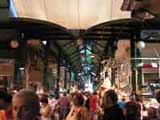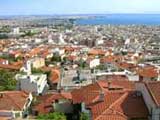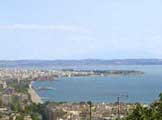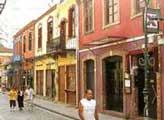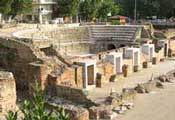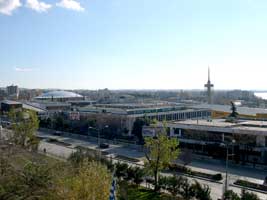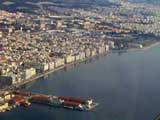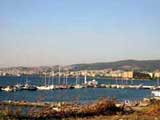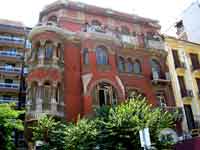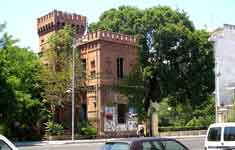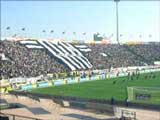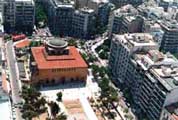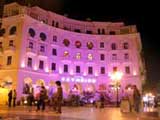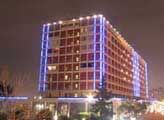.
Administrative Region : Central Macedonia
Regional unit : Thessaloniki
Thessaloniki (Greek: Θεσσαλονίκη [θesaloˈnici] ( listen)), historically also known as Thessalonica, Salonika or Salonica, is the second-largest city in Greece and the capital of the periphery of Central Macedonia[2] as well as the capital of the Decentralized Administration of Macedonia and Thrace.[3] Its honorific title is Συμπρωτεύουσα (Symprotévousa), literally "co-capital",[4] a reference to its historical status as the Συμβασιλεύουσα (Symvasilévousa) or "co-reigning" city of the Byzantine Empire, alongside Constantinople.[5]
According to the 2011 census the municipality of Thessaloniki today has a population of 322,240,[1] while the Thessaloniki Urban Area (the contiguous built up area forming the "City of Thessaloniki") has a population of 790,824;[1] making it the fifth largest and most populated city in the Balkans and the second most populated city that is not a capital. The Thessaloniki Metropolitan Area extends over an area of 1,455.62 km2 (562.02 sq mi) and its population in 2011 reached a total of 1,006,730 inhabitants.[1]
Thessaloniki is Greece's second major economic, industrial, commercial and political centre, and a major transportation hub for the rest of southeastern Europe;[6] its commercial port is also of great importance for Greece and the southeastern European hinterland.[6] The city is renowned for its festivals, events and vibrant cultural life in general,[7] and is considered to be Greece's cultural capital.[7] Events such as the Thessaloniki International Trade Fair and the Thessaloniki International Film Festival are held annually, while the city also hosts the largest bi-annual meeting of the Greek diaspora.[8]
Thessaloniki is home to numerous notable Byzantine monuments, including the Paleochristian and Byzantine monuments of Thessaloniki, a UNESCO World Heritage Site, as well as several Roman, Ottoman and Sephardic Jewish structures. With a history of over 2,300 years, it is one of Europe's oldest cities. The city's main university, Aristotle University, is the largest in Greece and in the Balkans.[9]
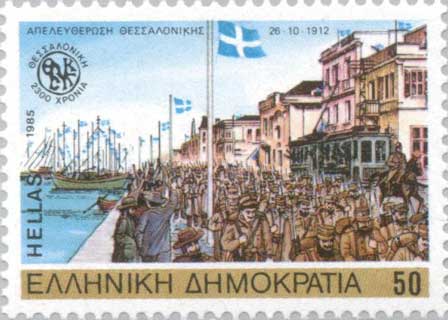
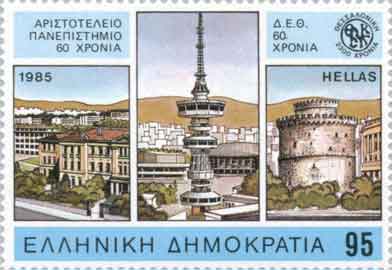
Etymology
Ancient Greek inscription reading "To Queen Thessalonice, (Daughter) of Philip".
All variations of the city's name derive from the original (and current) appellation in Greek: Θεσσαλονίκη, literally translating to "Thessalian Victory" and in origin the name of a princess, Thessalonike of Macedon, who was named so because she was born on the day of the Macedonian victory at the Battle of Crocus Field.[10]
The alternative name Salonika or Salonica, derived from the variant form Σαλονίκη (Saloníki) in popular Greek speech, gives rise to several languages' form of the city's name and is formerly the common name used in some western European languages. Names in other languages prominent in the city's history include Салуники (Soluniki) in Old Church Slavonic, Salonika in Ladino, Selanik (also Selânik) in Turkish (سلانیك in Ottoman Turkish), Solun (also written as Солун) in the local and neighboring South Slavic languages, Салоники (Saloníki) in Russian, and Sãrunã in Aromanian. In local speech, the city's name is typically pronounced with a dark and deepL characteristic of Macedonian Greek accent.[11][12] The name is often written in the abbreviated form Θεσ/νίκη.
History
Main article: History of Thessaloniki
The history of the city of Thessaloniki is a long one, dating back to ancient Macedonia. Since the opening of borders in Southeastern Europe following the collapse of Communism in the Balkans in the early 1990s, it has experienced a strong revival.
From antiquity to the Roman Empire
The Roman forum.
The city was founded around 315 BC by the King Cassander of Macedon, on or near the site of the ancient town of Therma and 26 other local villages.[13] He named it after his wife Thessalonike,[14] a half-sister of Alexander the Great and princess of Macedon as daughter of Philip II. Under the kingdom of Macedon the city retained its own autonomy and parliament[CN] and evolved to become the most important city in Macedon.[14]
After the fall of the kingdom of Macedon in 168 BC, Thessalonica became a free city of the Roman Republic.[14] It grew to be an important trade-hub located on the Via Egnatia,[15] the road connecting Dyrrhachium with Thessaloniki,[16] which facilitated trade between Thessaloniki and great centers of commerce such as Rome and Byzantium.[17] The city later became the capital of one of the four Roman districts of Macedonia.[15] Later it became the capital of all the Greek provinces of the Roman Empire due to the city's importance in the Balkan peninsula. When the Roman Empire was divided into the tetrarchy, Thessaloniki became the administrative capital of one of the four portions of the Empire under Galerius Maximianus Caesar,[18][19] where Galerius commissioned an imperial palace, a new hippodrome, a triumphal arch and a mausoleum among others.[19][20][21]
In 379 when the Roman Prefecture of Illyricum was divided between the East and West Roman Empires, Thessaloniki became the capital of the new Prefecture of Illyricum.[15] With the Fall of Rome in 476, Thessaloniki became the second-largest city of the Eastern Roman Empire.[17]
Medieval times and Byzantine era
Theodorus Gaza (c. 1400–1475), called "Thessalonicensis",[22] a Renaissance humanist and scholar of the 15th century from Thessaloniki.[23]
From the first years of the Byzantine Empire, Thessaloniki asserted itself as the second city in the Empire,[24][25][26] a status it held until it was finally transferred to Venice in 1423. The status of "second city" only to Constantinople was both in terms of wealth and size.[24] In the 1300s the city's population exceeded 100,000,[27][28] making it larger than London at the time.[29]
The economic expansion of the city continued through the 12th century as the rule of the Komnenoi emperors expanded Byzantine control to the north. Thessaloniki passed out of Byzantine hands in 1204,[30] when Constantinople was captured by the forces of the Fourth Crusade and incorporated the city and its surrounding territories in the Kingdom of Thessalonica[31] — which then became the largest vassal of the Latin Empire. In 1224, the Kingdom of Thessalonica was overrun by the Despotate of Epirus, a remnant of the former Byzantine Empire, under Theodore Komnenos Doukas who crowned himself Emperor,[32] and the city became the Despotat's capital.[32][33] This era of the Despotate of Epirus is also known as the Empire of Thessalonica.[32][34][35] Following his defeat at Klokotnitsa however in 1230,[32][34] the Empire of Thessalonica became a vassal state of the Second Bulgarian Empire until it was recovered again in 1246, this time by the Nicaean Empire.[32] In 1342,[36] the city saw the rise of the Commune of the Zealots, an anti-aristocratic party formed of sailors and the poor,[37] which is nowadays described as social-revolutionary.[36] The city was practically independent of the rest of the Empire,[36][37][38] as it had its own government, a form of republic.[36] The zealot movement was overthrown in 1350 and the city was reunited with the rest of the Empire.[36]
In 1423, Despot Andronicus, who was in charge of the city, ceded it to the Republic of Venice in the hope that it could be protected from the Ottomans who were besieging the city (there is no evidence to support the oft-repeated story that he sold the city to them). The Venetians held Thessaloniki until it was captured by the Ottoman Sultan Murad II on the 29th of March, 1430.[39]
Ottoman period
Murad II took Thessaloniki with a brutal massacre[40] and enslaved roughly one-fifth of the city's native population.[41] Upon the capture and plunder of Thessaloniki, many of its inhabitants escaped,[42] including intellectuals such as Theodorus Gaza “Thessalonicensis” and Andronicus Callistus.[43] However, the change of sovereignty from the Byzantine Empire to the Ottoman one did not affect the city's prestige as a major imperial city and trading hub.[44][45] Thessaloniki and Smyrna, although smaller in size than Constantinople, were the Ottoman Empire's most important trading hubs.[44] Thessaloniki's importance was mostly in the field of shipping,[44] but also in manufacturing,[45] while most of the city's trade was controlled by ethnic Greeks.[44]
During the Ottoman period, the city's Muslim and Jewish population grew. By 1478 Selânik (سلانیك), as the city came to be known in Ottoman Turkish, had a population of 4,320 Muslims, 6,094 Greek Orthodox and some Catholics, but no Jews. Soon after the turn of the 16th century, nearly 20,000 Sephardic Jews had immigrated to Greece from Spain following their expulsion.[40] By 1519, Sephardic Jews numbered 15,715, 54% of the city's population. Some historians consider the Ottoman regime's invitation to the Jews was a strategy to prevent the ethnic Greek population (Eastern Orthodox Christians) from dominating the city.[27]
The Ottoman Feth-i Bülend being sunk in Thessaloniki in 1912 by a Greek ship.
Selanik was the capital of the Selanik sanjak within the Rumeli Eyaleti (Balkans)[46] until 1826, and subsequently the capital of Selanik Vilayeti[47] (between 1826 and 1864 Selanik Eyaleti).[48] This consisted of the sanjaks of Selanik, Serres and Drama between 1826 and 1912.[49] Thessaloniki was also a Janissary stronghold[50] where novice Janissaries were trained. In June 1826, regular Ottoman soldiers attacked and destroyed the Janissary base in Thessaloniki while also killing over 10,000 Janissary,[50] an event known as The Auspicious Incident in Ottoman history.[50] From 1870, driven by economic growth, the city's population expanded by 70%, reaching 135,000 in 1917.[CN]
20th century onwards
Eleftherios Venizelos, political leader of the Movement of National Defence in Thessaloniki, inspects Greek troops on the Macedonian front during the First World War.
During the First Balkan War, on 8 November(26 October) 1912 (Old Style),[51] the feast day of the city's patron saint, Saint Demetrius,[51] the Greek Army accepted the surrender of the Ottoman garrison at Thessaloniki;[51] after the Second Balkan War, Thessaloniki and the rest of the Greek portion of Macedonia were officially annexed to Greece by the Treaty of Bucharest in 1913.[52]
In 1915, during World War I, a large Allied expeditionary force established a base at Thessaloniki for operations against pro-German Bulgaria.[53] This culminated in the establishment of the Macedonian Front, also known as the Salonika Front.[54][55] In 1916, pro-Venizelist Greek army officers and civilians, with the support of the Allies, launched the Movement of National Defence,[56] creating a pro-Allied[57] temporary government by the name of the "State of Thessaloniki"[56][58] that controlled "new lands" (lands that were gained by Greece in the Balkan Wars, most of Northern Greece);[56][58] the official government of the King in Athens, the "State of Athens",[56] controlled the "old lands"[56][58] which were traditionally monarchist. The State of Thessaloniki was disestablished with the unification of the two opposing Greek governments under Venizelos, following the abdication of King Constantine in 1917.[53][58]
Central Thessaloniki burning during the Great Fire of 1917.
Most of the old center of the city was destroyed by the Great Thessaloniki Fire of 1917, which started accidentally by an unattended kitchen fire on the 18th of August 1917.[59] The fire swept through the centre of the city, leaving 72,000 people homeless;[59] according to the Pallis Report, most of them were Jewish (50,000). As many businesses were destroyed, it resulted to 70% of the population being unemployed,[59] while also a number of religious structures of the three major faiths were lost. Nearly one-quarter of the total population of approximately 271,157 became homeless.[59] Following the fire the government prohibited quick rebuilding, so it could implement the new redesign of the city according to the European-style urban plan[5] prepared by a group of architects, including the British Thomas Mawson, headed by French architect Ernest Hébrard.[59] It is indicative that the Jewish community's properties were reduced from a value of 6.5 million Greek drachmas to 750,000.[60] Because of their losses and unable to wait for the rebuilding of the new plan, nearly half of the Jewish Greek population emigrated to France, the United States and Palestine.[CN]
German tank in Thessaloniki during the occupation.
After the defeat of Greece in the Greco-Turkish War and during the break-up of the Ottoman Empire, a population exchange took place between Greece and Turkey.[57] Over 160,000 ethnic Greeks from the former Ottoman Empire resettled in the city,[57] changing its demographics. Additionally many of the city's Muslims were deported to Turkey, ranging at about 20,000 people.[61] During the interwar period, Greece granted Jews full civil rights, the same as all other Greek citizens.[60]
During World War II, Thessaloniki fell to the forces of Nazi Germany on 8 April 1941[62] and remained under German occupation until 30 October 1944 when it was liberated by the Greek People's Liberation Army.[63] The Nazis soon forced the Jews into a ghetto near the railroads and on 15 March 1943 began the deportation process of the city's 56,000 Jews to its concentration camps.[64][65] They deported over 43,000 of the city's Jews in concentration camps,[64] where most were killed in the gas chambers. The Germans also deported 11,000 Jews to forced labor camps, where most perished.[66] The city suffered considerable damage from Allied bombing as they began to move against the Germans. Only 1,200 Jews live in the city today.
After the war, Thessaloniki was rebuilt with large-scale development of new infrastructure and industry throughout the 1950s, 1960s and 1970s. Many of its architectural treasures still remain, adding value to the city a tourist destination, while several early Christian and Byzantine monuments of Thessaloniki were added to the UNESCO World Heritage list in 1988.[67] In 1997, Thessaloniki was celebrated as the European Capital of Culture,[68] sponsoring events across the city and the region, while in 2004 the city hosted a number of the football events as part of the 2004 Summer Olympics.[69]
Today Thessaloniki has become one of the most important trade and business hubs in Southeastern Europe, with its port, the Port of Thessaloniki being one of the largest in the Aegean and fascilitating trade throughout the Balkan hinterland.[6] The city also forms one of the largest student centres in Southeastern Europe, is host to the largest student population in Greece and is a keen canditate for becoming European Youth Capital in 2014,[70] after it celebrates 100 years of union with Greece in 2012.[71]
Geography
Panoramic view of the city.
Geology
Thessaloniki and the surrounding areas from space (1996)
Thessaloniki lies on the northern fringe of the Thermaic Gulf on its eastern coast and is bound by Mount Chortiatis on its southeast. Its proximity to imposing mountain ranges, hills and fault lines, especially towards its southeast have historically made the city prone to geological changes.
Since midieval times, Thessaloniki was hit by strong earthquakes in 1759, 1902, 1978 and 1995.[72] On 19–20 June 1978, the city suffered a series of powerful earthquakes, registering 5.5 and 6.5 on the Richter scale.[73][74] The tremors caused considerable damage to a number of buildings and ancient monuments,[73] but the city withstood the catastrophe without any major problems.[74] One apartment building in central Thessaloniki collapsed during the second earthquake, killing many, raising the final death toll to 51.[73][74]
Climate
Situated next to the sea, the city's climate is directly effected by it.[75] The city has a Mediterranean climate (Köppen climate classification "Csa") that borders on a semi-arid climate (Köppen climate classification "BSk" or "BSh" depending on the system used) with annual average precipitation of 460 mm. Snowfalls are sporadic, but happen more or less every winter. Fog is common in the city, with an average of 193 foggy days in a year.[76]
The city lies in a transitional climatic zone, so its climate displays characteristics of continental and Mediterranean climates. Winters are relatively dry, with common morning frost. Snowfalls occur almost every year, but usually the snow does not stay for more than a few days. During the coldest winters, temperatures can drop to −10°C (14F).[76] The record minimum temperature in Thessaloniki was −14°C (7F).[77] On average, Thessaloniki spends 32 days a year below 0°C (32F).[76] The coldest month of the year in the city is January, with an average 24-hour temperature of 6°C (42F).[78] Wind is also usual in the winter months, with December and January having an average wind speed of 26 km/h (16 mph).[76]
Thessaloniki's summers are hot with rather humid nights.[76] Maximum temperatures usually rise above 30°C (86F),[76] but rarely go over 40C° (104F);[76] the average number of days when temperature was above 32°C (90F) was 32.[76] The maximum recorded temperature in the city was 42°C (108F).[76][77] Rain is seldom in summer, and mainly falls during thunderstorms. In the summer months Thessaloniki also experiences strong heat waves.[79] The hottest month of the year in the city is July, with an average 24-hour temperature of 26°C (80F).[78] The average wind speed for June and July in Thessaloniki is 20 km/h (12 mph).[76]
Climate data for Thessaloniki
Month Jan Feb Mar Apr May Jun Jul Aug Sep Oct Nov Dec Year
Average high °C (°F) 9.3
(48.7) 10.9
(51.6) 14.2
(57.6) 19.0
(66.2) 24.5
(76.1) 29.2
(84.6) 31.5
(88.7) 31.1
(88.0) 27.2
(81.0) 21.2
(70.2) 15.4
(59.7) 11.0
(51.8) 20.38
Daily mean °C (°F) 5.3
(41.5) 6.6
(43.9) 9.4
(48.9) 13.3
(55.9) 18.3
(64.9) 22.8
(73.0) 25.1
(77.2) 24.7
(76.5) 21.1
(70.0) 16.0
(60.8) 11.1
(52.0) 7.0
(44.6) 15.06
Average low °C (°F) 1.3
(34.3) 2.2
(36.0) 4.5
(40.1) 7.5
(45.5) 12.1
(53.8) 16.3
(61.3) 18.6
(65.5) 18.3
(64.9) 14.9
(58.8) 10.8
(51.4) 6.8
(44.2) 3.0
(37.4) 9.69
Precipitation mm (inches) 36.8
(1.449) 38.0
(1.496) 40.6
(1.598) 37.5
(1.476) 44.4
(1.748) 29.6
(1.165) 23.9
(0.941) 20.4
(0.803) 27.4
(1.079) 40.8
(1.606) 54.4
(2.142) 54.9
(2.161) 448.7
(17.665)
Avg. precipitation days 11 8 9 9 10 7 4 3 5 8 11 11 96
Sunshine hours 124 140 155 240 279 300 372 341 240 186 120 120 2,620
Source: World Meteorological Organization (UN),[80] BBC weather[81] for data of sunshine hours
Government
The Thessaloniki Urban Area.
Local government
See also: List of mayors of Thessaloniki
According to the Kallikratis reform, as of 1 January 2011 the Thessaloniki Urban Area (Greek: Πολεοδομικό Συγκρότημα Θεσσαλονίκης) which makes up the "City of Thessaloniki", is made up of six self-governing municipalities (Greek: Δήμοι) and one municipal unit (Greek: Δημοτική ενότητα). The municipalities that are included in the Thessaloniki Urban Area are those of Thessaloniki (the city center and largest in population size), Kalamaria, Neapoli-Sykies, Pavlos Melas, Kordelio-Evosmos, Ampelokipoi-Menemeni, and the municipal unit of Pylaia, part of the municipality of Pylaia-Chortiatis. Prior to the Kallikratis reform, the Thessaloniki Urban Area was made up of twice as many municipalities, considerably smaller in size, which created bureaucratic problems.[82]
The Command Post, now General Secretariat for Macedonia and Thrace, designed by Vitaliano Poselli in 1891.
Other
See also: Ministry for Macedonia and Thrace
Thessaloniki is the second largest city in Greece. It is an influential city for the northern parts of the country and is the capital of the Central Macedonia Periphery and the Thessaloniki Prefecture. The General Secretariat for Macedonia and Thrace is also based in Thessaloniki, being that the city is the de facto capital of the Greek region of Macedonia.
It is customary every year for the Prime Minister of Greece to announce his administration's policies on a number of issues, such as the economy, at the opening night of the Thessaloniki International Trade Fair. In 2010, during the first months of the 2010 Greek debt crisis, the entire cabinet of Greece met in Thessaloniki to discuss the country's future.[83]
Cityscape
The School of Education of Aristotle University.
Thessaloniki in the late 1910s.
Architecture
Architecture in Thessaloniki is the direct result of the city's position at the centre of all historical developments in the Balkans. Aside from its commercial importance, Thessaloniki was also for many centuries, the military and administrative hub of the region, and beyond this the transportation link between Europe and the Levant (Syria, Lebanon, Jordan, and Israel / Palestine). Merchants, traders and refugees from all over Europe settled in the city. The need for commercial and public buildings in this new era of prosperity led to the construction of large edifices in the city center. During this time, the city saw the building of banks, large hotels, theatres, warehouses, and factories.
The city layout changed after 1870, when the seaside fortifications gave way to extensive piers, and many of the oldest walls of the city were demolished, including those surrounding the White Tower, which today stands as the main landmark of the city. As parts of the early Byzantine walls were demolished, this allowed the city to expand east and west along the coast.[84]
The expansion of Eleftherias Square towards the sea completed the new commercial hub of the city and at the time was considered one of the most vibrant squares of the city. As the city grew, workers moved to the western districts, due to their proximity near factories and industrial activities; while the middle and upper classes gradually moved from the city-center to the eastern suburbs, leaving mainly businesses. In 1917, a devastating fire swept through the city and burned uncontrollably for 32 hours.[85] It destroyed the city's historic center and a large part of its architectural heritage, but paved way for many modern buildings and changed the city into a thriving European city center.
Panoramic view of Aristotelous Square, one of Thessaloniki's most recognizable areas, which was designed by Ernest Hebrard.
City Center
See also: Great Thessaloniki Fire of 1917
After the Great Thessaloniki Fire of 1917, a team of architects and urban planners including Thomas Mawson and Ernest Hebrard, a French architect, chose the Byzantine era as the basis of their (re)building designs for Thessaloniki’s city center. The new city plan included axes, diagonal streets and monumental squares, with a street grid that would channel traffic smoothly. The plan of 1917 included provisions for future population expansions and a street and road network that would be, and still is sufficient today.[85] It contained sites for public buildings and provided for the restoration of Byzantine churches and Ottoman mosques.
Today the city center of Thessaloniki includes the features designed as part of the plan and forms the point in the city where most of the public buildings, historical sites, entertainment venues and stores are located. The center is characterized by its many historical buildings, arcades, laneways and distinct architectural styles such as Art Nouveau and Art Deco, which can be seen on many of its buildings.
The city center, or as its also called the historic center is divided into several districts, of which include Ladadika (where many entertainment venues and tavernas are located), Kapani (where the central city market is located), Diagonios, Nauarinou, Rotonta, Agia Sofia and Ippodromio (white tower), which are all located around Thessaloniki’s most central point, Aristotelous Square.
The west point of the city center is home to Thessaloniki's law courts, its central international railway station and the port, while on its eastern side stands the city’s two universities, the Thessaloniki International Exhibition Center, the city’s main stadium, its archaeological and Byzantine museums, the new city hall and its central parklands and gardens, namely those of the Palios Zoologikos Kipos and Pedio tou Areos. The central road arteries that pass through the city center, designed in the Ernest Hebrard plan, include those of Tsimiski, Egnatia, Nikis, Mitropoleos, Venizelou and St. Demetrius avenues.
The Acropolis of Thessaloniki, reconstructed during the Byzantine and Ottoman years, which is part of the Walls.
Typical architecture of the Ano Poli (Upper Town) district.
View from Thessaloniki's Ano Poli and its walls. Part of southeastern Thessaloniki can also be seen on the left.
Ano Poli
Ano Poli (also called Old Town and literally the Upper Town) is the heritage listed district north of Thessaloniki’s city center that was not engulfed by the great fire of 1917 and was declared a UNESCO heritage site by ministerial actions of Melina Merkouri, during the 1980s. It consists of Thessaloniki’s most traditional part of the city, still featuring small stone paved streets, old squares and homes featuring old Greek and Ottoman architecture.
Ano Poli also, is the highest point in Thessaloniki and as such, is the location of the city’s acropolis, its Byzantine fort, the Heptapyrgion and the city's remaining walls, with many of its additional Ottoman and Byzantine structures still standing. The area provides access to the Seich Sou Forest National Park[86] and features amphitheatric views of the whole city and the Thermaic Gulf. On clear days Mount Olympus, at about 100 km (62 mi) away across the gulf, can also be seen towering the horizon.
Southeastern Thessaloniki
Southeastern Thessaloniki up until the 1920s was home to the city’s most affluent residents and formed the outermost suburbs of the city at the time, with the area close to the Thermaic Gulf coast called Exoches, meaning ‘the countryside’. Today southeastern Thessaloniki has in someway become a natural extension of the city center, with the avenues of Megalou Alexandrou, Georgiou Papandreou (Antheon), Vasilisis Olgas, Delfon, Konstantinou Karamanli (Nea Egnatia) and Papanastasiou passing through it; and the area extending to Kalamaria and Pylaia, about 9 km (5.59 mi) from the White Tower in the city centre.
Southeastern Thessaloniki is characterized by is modern architecture and apartment buildings, home to the middle-class and more than half of the municipality of Thessaloniki population. Today this area of the city is also home to 3 of the city’s main football stadiums, the Thessaloniki concert hall, the Posidonio aquatic and athletic complex and to many restored mansions of past affluent residents of the city, which today serve as museums or cultural centers. The municipality of Kalamaria is also located in southeastern Thessaloniki and has become this part of the city’s most sought after areas, with many open spaces and home to high end bars, cafés and entertainment venues, most notably on Plastira street, along the coast.
Northwestern Thessaloniki
Northwestern Thessaloniki had always been associated with industry and the working class due to the fact that as the city grew during the 1920s, many workers had moved there, due to its proximity near factories and industrial activities. Today many factories and industries have been moved further out west and the area is experiencing rapid growth as does the southeast. Many factories in this area have been converted to cultural centres, while past military grounds that are being surrounded by densely built neighborhoods are awaiting transformation into parklands.
Northwest Thessaloniki forms the main entry point into the city of Thessaloniki with the avenues of Monastiriou, Lagkada and 26is Septemvriou passing through it, as well as the extension of the A1 motorway, feeding into Thessaloniki's city center. The area is home to the Macedonia Central Bus Station (intercity buses terminal), the Zeitenlik Allied memorial military cemetery and to large entertainment venues of the city, such as Milos, Fix, Vilka (which are housed in converted old factories). Northwestern Thessaloniki is also home to Moni Lazariston, located in Stavroupoli, which today forms one of the most important cultural centers for the city.[87]
The church of Hagios Demetrios, built in the 4th century, is said to be the largest basilica in Greece and is one of the city's most prominent Paleochristian monuments.
Paleochristian and Byzantine monuments (UNESCO)
Main article: Paleochristian and Byzantine Monuments of Thessalonika
See also: Byzantine architecture
Due to Thessaloniki's importance during the early Christian and Byzantine periods, the city is host to several paleochristian monuments that have significantly contributed to the development of Byzantine art and architecture throughout the Byzantine Empire as well as Serbia.[67] The evolution of Imperial Byzantine architecture and the prosperity of Thessaloniki go hand in hand, especially during the first years of the Empire,[67] when the city continued to flourish. It was at that time that the Complex of Roman emperor Galerius was built, as well as the first church of Hagios Demetrios.[67]
By the 8th century, the city had become an important administrative center of the Byzantine Empire, and handled much of the Empire's Balkan affairs.[88] During that time, the city saw the creation of more notable Christian churches that are now UNESCO World Heritage Sites, such as Hagia Sophia of Thessaloniki, the Rotunda of Saint George, the Church of the Acheiropoietos, the Church of Panagia Chalkeon.[67] When the Ottoman Empire took control of Thessaloniki in 1430, most of the city's churches were converted into mosques,[67] but have survived to this day. Travelers such as Paul Lucas and Abdul Mecid[67] document the city's wealth in Christian monuments during the years of the Ottoman control of the city.
The church of Hagios Demetrios was burnt down during the Great Thessaloniki Fire of 1917, as did many other of the city's monuments, but it was rebuilt. During the Second World War, the city was extensively bombed and as such many of Thessaloniki's paleochristian and Byzantine monuments were heavily damaged.[88] Some of the sites were not restored until the 1980s. Thessaloniki has more UNESCO World Heritage Sites listed than any other city in Greece, a total of 15 monuments.[67] They have been listed since 1988.[67]
Thessaloniki 2012 Program
The upper seaside promenade as it was before work commenced in August 2011.
In regards to the 100th anniversary of the incorporation of Thessaloniki into Greece, during 1912, the government announced a large-scale redevelopment program for the city of Thessaloniki, which aims in addressing the current environmental and spatial problems[89] that the city faces. More specifically, the program will drastically change the physiognomy of the city[89] by relocating the Thessaloniki International Exhibition Center and grounds of the Thessaloniki International Trade Fair outside the city centre and turning the current location into a large metropolitan park,[90] redeveloping the coastal front of the city,[90] relocating the city's numerous military camps and using the grounds and facilities to create large parklands and cultural centers;[90] and the complete redevelopment of the harbor and the Lachanokipoi and Dendropotamos districts (behind and near the Port of Thessaloniki) into a thriving business district,[90] with possible highrise developments.[91]
The plan also envisions the creation of new wide avenues in the outskirts of the city[90] and the creation of pedestrian-only zones in the city center.[90] Furthermore, the program includes plans to expand the jurisdiction of Seich Sou Forest National Park[89] and the improvement of accessibility to and from the Old Town.[89] The ministry has said that the project will take an estimated 15 years to be completed, in 2025.[90]
Part of the plan has been implemented with the revitalization of half the eastern urban waterfront (Greek: Νέα Παραλία, Nea Paralia, literally new beach), with a modern and vibrant design. The municipality of Thessaloniki's budget for the reconstruction of important areas of the city and most notably the rest of the waterfront, is estimated to be around €28.2 million (US$39.9 million) for the year 2011 alone.[92] As of August 2011 work on the rest of the plan for the revilatization of the waterfront has began, stretching from the Thessaloniki yacht club to the White Tower.[93] It is estimated that the new parks will be completed within the next two years at a total cost of over 20 million euro.[93] Once complete, the entire city's Nea Paralia will feature thematic parks.[93]
Economy
The MS Westerdam at the port of Thessaloniki.
The building of the National Bank of Greece.
Thessaloniki is a major port city and an industrial and commercial centre. The city's industries centre around oil, steel, petrochemicals, textiles, machinery, flour, cement, pharmaceuticals, and liquor.
Thessaloniki's old market (Kapani), in the city centre
The city's port, the Port of Thessaloniki, is one of the largest ports in the Aegean and as a free port, it functions as a major gateway to the Balkan hinterland.[6][94] In the first six months of 2010, more that 7.2 million tons of products went through the city's port,[95] making it one of the largest and most used ports in the Balkans. As a result of this, the city is a major transportation hub for the whole of south-eastern Europe,[96] carrying among other things, trade to and from the neighbouring countries. Recently Thessaloniki is also slowly turning into a major port for cruising in the eastern Mediterranean.[94] The Greek ministry of tourism considers Thessaloniki to be Greece's second most important commercial port,[97] and companies such as Royal Caribbean International have expressed interested in adding the Port of Thessaloniki to their destinations.[97] A total of 30 cruise ships are expected to arrive at Thessaloniki in 2011.[97]
In recent years, the city has suffered industrial restructuring and lost many jobs; while it is moving toward a more service-based economy. A spate of factory shut downs has occurred as companies take advantage of cheaper labour markets and more lax regulations in other areas. Among the largest companies to shut down factories are Goodyear,[98] AVEZ (the first industrial factory in northern Greece, built in 1926),[99] and VIAMIL (ΒΙΑΜΥΛ). Nevertheless Thessaloniki still remains a major business hub in the Balkans, with a number of important Greek companies headquartered in the city, such as the Hellenic Vehicle Industry, the Macedonian Milk Industry and Philkeram Johnson. A considerable percentage of the city's working force is employed in small and medium-sized businesses, as well as in the service and the public sectors.
The GDP of the prefecture of Thessaloniki was €18.4 billion (US$25.4 billion) in 2004,[100] and the GDP per capita of the prefecture was €17,394 (US$24,027),[100] which was above Greece's GDP per capita at the time (US$20,000).[101]
Demographics
Historical ethnic statistics
The tables below show the ethnic statistics of Thessaloniki during the end of 19th and the beginning of 20th century.
Year Total Population Jewish Population Turkish (Muslim) Population Greek Population Bulgarian Population Roma Population Other groups
1890[102] 118,000 55,000 26,000 16,000 10,000 2,500 8,500
around 1913[103] 157,889 61,439 45,889 39,956 6,263 2,721 1,621
Population growth
Ethnic composition of Thessaloniki between 1500 and 1950.
The population growth of the municipality of Thessaloniki since 1348.
The municipality of Thessaloniki is the most populated municipality of all the municipalities that are part of the Thessaloniki Urban Area and make up the "City of Thessaloniki". Although the population of the municipality of Thessaloniki has declined in the latest census, the metropolitan area's population is still growing. The city forms the base of the Thessaloniki Metropolitan Area, with latest census in 2011 giving it a population of 1,006,730.[1]
Population of Thessaloniki Year Flag of Thessaloniki.svg Municipality Urban area Metropolitan area Rank
1348 150,000[28] – – Byzantine Empire 2nd
1453 40,000[28] – – –
1679 36,000[104] – – –
1842 70,000[105] – – –
1870 90,000[105] – – –
1882 85,000[105] – – –
1890 118,000 – – –
1902 126,000[105] – – –
1913 157,000[85] – – Greece 2nd
1917 230,000[85] – – Greece 2nd
1981 406,413 – – Greece 2nd
1991 383,967[106] – – Greece 2nd
2001 363,987[106] 786,212[106] 954,027[106] Greece 2nd
2004 386,627[107] – 995,766[107] Greece 2nd
2011 322,240[1] 790,824[1] 1,006,730[1] Greece 2nd
The Jews of Thessaloniki
Main article: History of the Jews of Thessaloniki
Jewish woman of Thessaloniki, gravour of late 19th century.
Registration of the male Jews by Nazis at the center of Thessaloniki (Eleftherias square).
"Jews not welcome" sign during the occupation.
Jewish Museum of Thessaloniki.
The Jewish population in Greece was the oldest in mainland Europe, and was mostly Sephardic. Thessaloniki became the largest center of the Sephardic Jews, who nicknamed the city la madre de Israel (Israel's mother)[64] and "Jerusalem of the Balkans". [108] It also included the historically significant and ancient Greek-speaking Romaniote community. During the Ottoman era, Thessaloniki's Sephardic community comprised more than half the city's population; the Jews were dominant in commerce until the ethnic Greek population increased after independence in 1912. By the 1680s, about 300 families of Sephardic Jews, followers of Sabbatai Zevi, had converted to Islam, becoming a sect known as the Dönmeh (convert), and migrated to Salonika, whose population was majority Jewish. They established an active community that thrived for about 250 years. Many of their descendants later became prominent in trade.[109] Many Jewish inhabitants of Thessaloniki spoke Ladino, the Romance language of the Sephardic Jews.[110]
The great fire of 1917 burned much of the center of the city and left 50,000 Jews homeless of the total of 72,000 residents who were burned out.[60] Having lost homes and their businesses, many Jews emigrated: to the United States, Palestine, and Paris. They could not wait for the government to create a new urban plan for rebuilding, which was eventually done.[111]
After the Greco-Turkish War in 1922 and the expulsion of Greeks from Turkey, many refugees came to Greece. Nearly 100,000 ethnic Greeks resettled in Thessaloniki, reducing the proportion of Jews in the total community. After this, Jews made up about 20% of the city's population. During the interwar period, Greece granted the Jews the same civil rights as other Greek citizens.[60] In March 1926, Greece re-emphasized that all citizens of Greece enjoyed equal rights, and a considerable proportion of the city's Jews decided to stay.
World War II brought a disaster for the Jewish Greeks, since in 1941 the Germans occupied Greece and began actions against the Jewish population. Greeks of the Resistance and Italian forces (before 1943) tried to protect the Jews and managed to save some.[64] By the 1940s, the great majority of the Jewish Greek community firmly identified as both Greek and Jewish. According to Misha Glenny, such Greek Jews had largely not encountered "anti-Semitism as in its North European form."[112]
In 1943 the Nazis began actions against the Jews in Thessaloniki, forcing them into a ghetto near the railroad lines and beginning deportation to concentration and labor camps. They deported and exterminated approximately 96% of Thessaloniki's Jews of all ages during the Holocaust.[64] Today, a community of around 1200 remains in the city.[64] Communities of descendants of Thessaloniki Jews – both Sephardic and Romaniote – live in other areas, mainly the United States and Israel.[64] Israeli singer Yehuda Poliker recorded a song about the Jews of Thessaloniki, called "Wait for me, Thessaloniki".
Year Total
population Jewish
population Jewish
percentage Source[60]
1842 70,000 36,000 51% Jakob Philipp Fallmerayer
1870 90,000 50,000 56% Greek schoolbook (G.K. Moraitopoulos, 1882)
1882/84 85,000 48,000 56% Ottoman government census
1902 126,000 62,000 49% Ottoman government census
1913 157,889 61,439 39% Greek government census
1917 271,157 52,000 19% [113]
1943 50,000
2000 363,987[106] 1,000 0.27%
Culture
Leisure and entertainment
Olympion Theater in Aristotelous Square.
Makedonia Palace at night.
Thessaloniki is not only regarded as the cultural and entertainment capital of northern Greece[88][114] but also the cultural capital of the country.[7] The city's main theaters, run by the National Theater of Northern Greece (Greek: Κρατικό Θέατρο Βορείου Ελλάδος) which was established in 1961,[115] include the Theater of the Society of Macedonian Studies, where the National Theater is based, the Royal Theater, the first base of the National Theater, Moni Lazariston, and the Earth Theater and Forest Theater, both amphitheatrical open-air theatres overlooking the city.[115] The title of the European Capital of Culture in 1997 saw the birth of the city's first opera[116] and today forms an independent section of the National Theatre of Northern Greece.[117] The opera is based at the Thessaloniki Concert Hall, one of the largest concert halls in Greece. Recently a second building was also constructed and designed by Japanese architect Arata Isozaki. Olympion Theater, the site of the Thessaloniki International Film Festival and the Plateia Assos Odeon multiplex are the two major cinemas in downtown Thessaloniki. The city also has a number of multiplex cinemas in major shopping malls in the suburbs, most notably in Mediterranean Cosmos, the largest retail and entertainment development in the Balkans.
Thessaloniki is renowned for its major shopping streets and lively laneways. Tsimiski Street and Proxenou Koromila avenue are the city's most famous shopping streets and are among Greece's most expensive and exclusive high streets. The city is also home to one of Greece's most famous and prestigious hotels, Makedonia Palace hotel, the Hyatt Regency Casino and hotel (the biggest casino in Greece and one of the biggest in Europe) and Waterland, the largest water park in southeastern Europe.
The city has always been known between Greeks for its vibrant city culture, including having the most cafe's and bars per-capita than any other city in Europe; and as having some of the best nightlife and entertainment in the country, thanks to its large young population and multicultural feel. Only recently has the city been exposing itself to the world and becoming more known for what it is, with Lonely Planet listing Thessaloniki as the world's fifth-best ultimate party city.[118]
Part of the coastline of the southeastern suburb of Peraia in Thermaikos, with views towards Thessaloniki.
Parks and recreation
Although Thessaloniki is not renowned for its parks and greenery throughout its urban area, where green spaces are low, it has several large open spaces around its waterfront, namely the central city gardens of ΧΑΝΘ/Palios Zoologikos Kipos (which is recently being redeveloped to also include rock climbing facilities, a new skatepark and paintball range),[119] the park of Pedio tou Areos, pulling in crowds throughout the year, and the parks of the Nea Paralia (waterfront) that span for 3 km (2 mi) along the coast, from the White Tower to the concert hall.
The Nea Paralia parks are used throughout the year for a variety of events, while they open up to the Thessaloniki waterfront, which is lined up with several cafés and bars; and during summer is full of Thessalonians enjoying their long evening walks (referred to as "the volta" and is embedded into the culture of the city). Today half of the waterfront has been revitalised, while works have already started for the revitalisation of the rest, to include a further 8 thematic gardens with the large modernisation overhaul.[120]
Thessaloniki’s proximity to places such as the national parks of Pieria and beaches of Chalkidiki often allow its residents to easily have access to some of the best outdoor recreation in Europe, however the city is also right next to the Seich Sou forest national park, just 3.5 km (2 mi) away from Thessaloniki’s city center; and offers residents and visitors alike, quiet viewpoints towards the city, mountain bike trails and landscaped hiking paths.[121]
Other recreation spaces throughout the Thessaloniki Metropolitan Area include the Fragma Thermis, a landscaped parkland near Thermi and the Delta wetlands west of the city center; while urban beaches that have continuously been awarded the blue flags,[122] are located along the 10 km (6 mi) coastline of Thessaloniki's southeastern suburbs of Thermaikos, about 20 km (12 mi) away from the city center.
Museums and galleries
Main article: List of museums in Greece
Due to the city's rich and diverse history, Thessaloniki houses many museums dealing with many different eras in history. Two of the city center's most famous museums include the Archaeological Museum of Thessaloniki and the Museum of Byzantine Culture.
The Archaeological Museum of Thessaloniki was established in 1962 and houses some of the most important ancient Macedonian artifacts,[123] including an extensive collection of golden artwork from the royal palaces of Aigai and Pella.[124] It also houses exhibits from Macedon's prehistoric past, dating from the Neolithic to the Bronze age.[125] The Prehistoric Antiquities Museum of Thessaloniki has exhibits from those periods as well.
The Museum of Byzantine Culture is one of the city's most famous museums, showcasing the city's glorious Byzantine past.[126] The museum was also awarded Council of Europe's museum prize in 2005.[127] The museum of the White Tower of Thessaloniki houses a series of galleries relating to the city's past, from the creation of the White Tower until recent years.[128]
The planetarium at the Thessaloniki Science Center and Technology Museum.
One of the most modern museums in the city is the Thessaloniki Science Center and Technology Museum and is one of the most high-tech museums in Greece and southeastern Europe.[129] It features the largest planetarium in Greece, a cosmotheater with the largest flat screen in Greece, an amphitheater, a motion simulator with 3D projection and 6-axis movement and exhibition spaces.[129] Other industrial and technological museums in the city include the Railway Museum of Thessaloniki, which houses an original Orient Express train, the War Museum of Thessaloniki and others. The city also has a number of educational and sports museums, including the Thessaloniki Olympic Museum and the Sports Museum of Thessaloniki.
The Atatürk Museum in Thessaloniki is the historic house where Mustafa Kemal Atatürk, founder of modern-day Turkey, was born. The house is now part of the Turkish consulate complex, but admission to the museum is free.[130] The museum contains historic information about Mustafa Kemal Atatürk and his life, especially while he was in Thessaloniki.[130] Other ethnological museums of the sort include the Historical Museum of the Balkan Wars, the Jewish Museum of Thessaloniki and the Museum of the Macedonian Struggle, containing information about the freedom fighters in Macedonia and their struggle to liberate the region from the Ottoman yoke.[131]
The city also has a number of important art galleries. Such include the Macedonian Museum of Contemporary Art, housing exhibitions from a number of well-known Greek and foreign artists.[132] The Teloglion Foundation of Art is part of Aristotle University of Thessaloniki and includes an extensive collection of works by important artists of the 19th and 20th centuries, including works by prominent Greeks and native Thessalonians.[133] The Thessaloniki Museum of Photography also houses a number of important exhibitions, and is located within the old port of Thessaloniki.[134]
Festivals
Main article: Festivals of Thessaloniki
Prime Minister George Papandreou outlining his government's policies at the Thessaloniki International Trade Fair in 2009.
Thessaloniki is home of a number of festivals and events. The Thessaloniki International Trade Fair is the most important event to be hosted in the city annually, by means of economic development. It was first established in 1926[135] and takes place every year at the 180,000 m2 (1,937,503.88 sq ft) Thessaloniki International Exhibition Center. The event attracts major political attention and it is customary for the Prime Minister of Greece to outline his administration's policies for the next year, during event. Over 250,000 visitors attended the exposition in 2010.[136]
The Thessaloniki International Film Festival is established as one of the most important film festivals in Southern Europe,[137] with a number of notable film makers such as Francis Ford Coppola, Faye Dunaway, Catherine Deneuve, Irene Papas and Fatih Akın taking part, and was established in 1960.[138] The Documentary Festival, founded in 1999, has focused on documentaries that explore global social and cultural developments, with many of the films presented being candidates for FIPRESCI and Audience Awards.[139]
The Dimitria festival is held annually.
The Dimitria festival, founded in 1966 and named after the city's patron saint of St. Demetrius, has focused on a wide range of events including music, theatre, dance, local happenings, and exhibitions.[140] The "DMC DJ Championship" has been hosted at the International Trade Fair of Thessaloniki and has become a worldwide event for aspiring DJs and turntablists. The "International Festival of Photography" has taken place every February to mid-April.[141] Exhibitions for the event are sited in museums, heritage landmarks, galleries, bookshops and cafés. Thessaloniki also holds an annual International Book Fair.[142]
Between 1962–1997 and 2005–2008 the city also hosted the Thessaloniki Song Festival,[143] Greece's most important music festival, at Alexandreio Melathron.[144]
Sports
The main stadium of the city is the Kaftanzoglio Stadium (also home ground of Iraklis FC), while other main stadiums of the city include the football Toumba Stadium and Kleanthis Vikelidis Stadium, home grounds of PAOK FC and Aris FC respectively, all of whom are founding members of the Greek league.
Being the largest "multi-sport" stadium in the city, Kaftanzoglio Stadium regularly plays host to athletics events; such as the European Athletics Association event "Olympic Meeting Thessaloniki" every year; it has hosted the Greek national championships in 2009 and has been used for athletics at the Mediterranean Games and for the European Cup in athletics. In 2004 the stadium served as an official Athens 2004 venue,[145] while in 2009 the city and the stadium hosted the 2009 IAAF World Athletics Final.
Thessaloniki Olympic Museum.
Kaftanzoglio National Stadium.
Thessaloniki's major indoor arenas include the state-owned Alexandreio Melathron, PAOK Sports Arena and the YMCA indoor hall. Other sporting clubs in the city include Apollon FC based in Kalamaria, Agrotikos Asteras FC based in Evosmos and YMCA. Thessaloniki has a rich sporting history with its teams winning the first ever panhellenic football,[146] basketball,[147] and water polo[148] tournaments.
The city played a major role in the development of basketball in Greece. The local YMCA was the first to introduce the sport to the country, while Iraklis BC won the first ever Greek championship.[147] From 1982 to 1993 Aris BC dominated the league, regularly finishing in first place. In that period Aris won a total of 9 championships, 7 cups and one European Cup Winners' Cup. In volleyball, Iraklis has emerged since 2000 as one of the most successful teams in Greece[149] and Europe.[150][151] In October 2007, Thessaloniki also played host to the first Southeastern European Games.[152]
The city is also the finish point of the annual Alexander The Great Marathon, which starts at Pella, in recognition of its Ancient Macedonian heritage.[153]
Main sports clubs in Thessaloniki Club Founded Venue Capacity
Iraklis 1908 Kaftanzoglio National Stadium Olympic Rings.svg 27,770
Aris 1914 Kleanthis Vikelidis Stadium 22,800
1922 Alexandreio Melathron (Palais des Sports) 5,500
PAOK 1926 Toumba Stadium 28,703
PAOK Sports Arena 8,700
YMCA Thessaloniki (ΧΑΝΘ) 1921
Apollon 1926 Kalamaria Stadium 6,500
MENT 1926
VAO 1926
Makedonikos 1928 Makedonikos Stadium 8,100
Agrotikos Asteras 1932 Evosmos Stadium
Media
OTE Tower is the tallest telecommunications tower in Greece.
Thessaloniki is home to the ERT3 TV-channel and Radio Macedonia, both services of Hellenic Broadcasting Corporation (ERT) operating in the city and are broadcast all over Greece.[154] The municipality of Thessaloniki also operates three radio stations, namely FM100, FM101 and FM100.6;[155] and TV100, a television network which was also the first non-state-owned TV station in Greece and opened in 1988.[155] Several private TV-networks also broadcast out from Thessaloniki, with Makedonia TV being the most popular.
The city's main newspapers and some of the most circulated in Greece, include Makedonia, which was also the first newspaper published in Thessaloniki in 1911 and Aggelioforos. A large number of radio stations also broadcast from Thessaloniki as the city is known for its music contributions.
Notable Thessalonians
Main article: List of Thessalonians
Throughout its history, Thessaloniki has been home to a number of well-known figures. It is also the birthplace of various Saints and other religious figures, such as Cyril and Methodius, creators of the first Slavic alphabet, Saint Mitre, Patriarch Philotheus I of Constantinople and Archbishop Demetrios of America. Many of Greece's most celebrated musicians and movie stars were born in Thessaloniki, such as Zoe Laskari, Costas Hajihristos, Antonis Remos, Paschalis Terzis, Natassa Theodoridou, Katia Zygouli, Kostas Voutsas, Stavros Damianides, Marios Iliopoulos and Marinella. Additionally, there have been a number of political leaders born in the city Evangelos Venizelos, the current Minister of Finance of Greece, Haris Kastanidis, current Minister for the Interior, Christos Sartzetakis, fourth President of Greece, Kostas Zouraris and Ioannis Passalidis. Sports personalities from the city include Eleni Daniilidou, Dimitris Salpigidis, Traianos Dellas, Kleanthis Vikelidis and Ioannis Tamouridis. Ioannis Papafis and Elias Petropoulos were also born in Thessaloniki.
The city is also the birthplace of a number of important foreign personalities, which include ethnic Macedonians (Dimo Todorovski), Bulgarians (Atanas Dalchev), Turks (Nâzım Hikmet, Mustafa Kemal Atatürk, Afet İnan, Cahit Arf, Mehmet Cavit Bey, Salih Omurtak, Sabiha Sertel, Halil Rifat Pasha) and Israelites (Moshe Levy, Daniel Zion, Samuel ben Joseph Uziel, Shlomo Halevi Alkabetz).
Thessaloniki in popular culture
The city is viewed as a romantic one in Greece, and as such Thessaloniki is commonly featured in Greek songs.[156] There are a number of famous songs that go by the name 'Thessaloniki' or include the name in their title.[157]
Education
Main articles: Aristotle University and University of Macedonia
The School of Philosophy of Aristotle University, the oldest building in the campus.
Thessaloniki is a major center of education for Greece. Two of the country's largest universities are located in central Thessaloniki: Aristotle University and the University of Macedonia. Aristotle University was founded in 1926 and is currently the largest university in Greece[9] by number of students, which number at more than 80,000 in 2010,[9] and is a member of the Utrecht Network. For the academic year 2009-2010, Aristotle University was ranked as one of the 150 best universities in the world for arts and humanities and among the 250 best universities in the world overall by the Times QS World University Rankings,[158] making it one of the top 2% of best universities worldwide.[159] Leiden ranks Aristotle University as one of the top 100 European universities and the best university in Greece, at number 97.[160] Since 2010, Thessaloniki is also home to the Open University of Thessaloniki,[161] which is funded by Aristotle University, the University of Macedonia and the municipality of Thessaloniki.
Additionally, a TEI (Technological Educational Institute) is located in the western suburb of Sindos, home also to the industrial zone of the city. Numerous public and private vocational institutes (Greek: IEK) provide professional training to young students, while a large number of private colleges offer American and UK academic curriculum, via cooperation with foreign universities. In addition to Greek students, the city hence attracts many foreign students either via the Erasmus programme for public universities, or for a complete degree in public universities or in the city's private colleges. As of 2006 the city's total student population was estimated around 200,000.[162]
Transport
Bus transport
Main article: Thessaloniki Urban Transport Organization
An OASTH bus.
Public transport in Thessaloniki is served by buses. The bus company operating in the city is the Thessaloniki Urban Transport Organization (OASTH) and is the only public means of transport in Thessaloniki at the moment. It operates a fleet of 604 vehicles on 75 routes throughout the Thessaloniki Metropolitan Area. International and regional bus links are provided at the Macedonia Central Bus Station (intercity buses terminal), located west of the city centre.
Railways
Main article: New Railway Station
See also: Proastiakos
The city is a major railway hub for the Balkans, with direct connections to Sofia, Skopje, Belgrade, Moscow, Vienna, Budapest, Bucharest and Istanbul, alongside Athens and other destinations in Greece. It is the most important railway hub of Greece and has the biggest marshalling yard in the country.
View of the railway station.
Thessaloniki's railway passenger station, is called the "New Railway Station" and was completed in 1961,[163] remaining largely unchanged ever since. Currently it features large waiting areas, a central hall, cafes, restaurants and a shopping center. Discussions are underway for the expansion of the station and a general modernisation overhaul, which will also include a hotel and a revamp of the central offices of the Hellenic Railways Organization for northern Greece.[164] A metro station is currently also under construction at the station.
Commuter rail services have recently been established between Thessaloniki and the city of Larissa (the service is known in Greek as the "Proastiakos", meaning "Suburban Railway"). The service operates using Siemens Desiro EMU trains on a modernised electrified double track and stops at 11 refurbished stations, covering the journey in an 1 hour and 33 minutes. An additional commuter rail service has also been established, although with the use of regional trains, between Thessaloniki and the city of Edessa. The train service within Greece, including the Proastiakos, is operated by TrainOSE, the Hellenic Railways Organization's train operating company. As of 2011, due to the financial crisis international services have been suspended.
Thessaloniki Metro
Main article: Thessaloniki Metro
Thessaloniki Metro map.
The construction of the Thessaloniki Metropolitan Railway began in 2006 and is scheduled for completion in late 2014.[165] The line of Phase 1 is set to extend over 9.6 kilometres (6.0 mi), include 13 stations[166] and it is expected to eventually serve 250,000 passengers daily.[167] Some stations of the Thessaloniki Metro will house a number of archaeological finds.[168]
Discussions are already underway for future expansions, in order for the metro network to also serve major transport hubs of the city, notably the Macedonia Central Bus Station (intercity buses terminal) and Macedonia International Airport. For the expansion towards the airport, the Attiko Metro company is considering the construction of an overground network or a monorail. The expansion to Kalamaria, a southeast borough of Thessaloniki, has already become part of the initial construction phase, while future expansions are considered and planned for Efkarpia to the north and Evosmos to the west. The strategic plan for the construction of the Thessaloniki Metro envisions that the city will have a system of 3 lines by 2018 or 2020 at the latest.[169]
Macedonia International Airport
Main article: Macedonia International Airport
Macedonia International Airport passengers' terminal.
Air traffic to and from the city is served by Macedonia International Airport for international and domestic flights. The short length of the airport's two runways means that it does not currently support intercontinental flights, although a major extension, lengthening one of its runways into the Thermaic Gulf is under construction, despite considerable opposition from local environmentalist groups. Following the completion of the runway works, the airport will be able to serve intercontinental flights and cater for larger aircraft in the future. A master-plan, with designs for a new terminal building and apron have also been released; and is seeking for either public and private funding.
Motorways
Further information: List of Greek roads
Road map of Thessaloniki and its suburbs from OpenStreetMap.
The city is bypassed by a C-shaped ring road. The western end of the route begins at the junction with the A1/A2 motorways in Lachanagora District. Clockwise it heads northeast around the city, passing through the northwestern suburbs, the forest of Seich Sou and through to the southeast borough of Kalamaria. The ring road ends at a large junction with the ΕΟ67 (in the near future to be expanded as A25) motorway, which then continues south to Chalkidiki, passing through Thessaloniki's outer southeast suburbs. This route is labeled as the Esoteriki Peripheriaki Odos (Greek: Εσωτερική Περιφεριακή Οδός, inner ring road) of Thessaloniki and is generally accepted as the "boundary" between the city proper (Thessaloniki Urban Area) and its suburbs.
The speed limit on this motorway is 90 kilometres per hour (56 mph), it currently has three traffic lanes for each direction and forms the city's most vital road link. Although the large efford that was made in 2004 to improve the motorway features, it still does not feature an emergency lane. New plans have surfaced to upgrade the motorway to address the current issues, while also adding one more lane in each direction.
An outer ring road known as Eksoteriki Peripheriaki Odos (Greek: Εξωτερική Περιφεριακή Οδός, outer ring road) is planned, with its west part already built and running as part of the A1/A2 motorways, passing through the outer northwestern suburbs of the city.
Motorways:
A1/E75 W (FYROM (Former Yugoslav Republic of Macedonia) , Athens, Larissa)
A2/E90 N' (Turkey, Alexandroupolis, Kavala, Xanthi, Igoumenitsa, Ioannina, Kozani)
A25(ΕΟ12)/Ε79 Ν (Serres, Bulgaria)
A25(ΕΟ67) S (Airport, Nea Moudania)
National Roads:
ΕΟ12/Ε79 Ν (Serres, Drama)
ΕΟ16, SW (Polygyros, Ouranopolis)
ΕΟ65, Ν (Kilkis, Doirani)
International relations
Commemorative stele in Melbourne.
Twin towns — Sister cities
See also: List of twin towns and sister cities in Greece
Thessaloniki is twinned with:[170]
Towns
United States Hartford, United States since March 5, 1962[171]
Egypt Alexandria, Egypt, since July 12, 1993
Italy Bologna, Italy, since October 20, 1984
Slovakia Bratislava, Slovakia, since April 23, 1986[172]
Germany Cologne, Germany, since May 3, 1988
Romania Constanţa, Romania, since July 5, 1988
Turkey Akhisar, Turkey, since August 25, 1988
India Kolkata, India since January 1, 2005
Albania Korçë, Albania since October 14, 2005
Germany Leipzig, Germany, since October 17, 1984
Cyprus Limassol, Cyprus, since June 30, 1984
Australia Melbourne, Australia since March 19, 1984[173]
France Nice, France, since March 20, 1992
Bulgaria Plovdiv, Bulgaria, since February 27, 1984
United States San Francisco, United States since August 6, 1990[174]
Israel Tel Aviv, Israel, since November 24, 1994
Turkey Amasya, Turkey, since August 25, 2001
China Tianjin, China since March 4, 2002
China Dongguan, China since October 24, 2008
South Korea Busan, South Korea since March 8, 2010
Collaborations
United States Boston, United States since April 21, 1996
United States Brooklyn Center, United States since July 5, 1992
Hungary Budapest, Hungary since April 5, 1993
Ukraine Dnipropetrovsk, Ukraine since April 18, 2003
Armenia Gyumri, Armenia since November 23, 2000
France Marseille, France, since June 4, 1991
United States Philadelphia, United States since April 1, 2004
Russia Saint Petersburg, Russia, since 2003
China Shenyang, China since March 23, 2000
Canada Toronto, Canada since September 5, 1986
Italy Venice, Italy, since July 17, 2003
Libya Tripoli, Libya, since June 23, 2007
Turkey İzmir, Turkey, since February 6, 2009
Gallery
Detail from the Arch of Galerius.
View of Yeni Mosque, built during the ottoman period.
Aerial view of the City Centre.
The Metropolitan Church of Saint Gregory Palamas.
Thessaloniki Science Center and Technology Museum (also known as NOESIS).
Art Nouveau building at the center of the city.
View of the seafront.
View of Thessaloniki center.
Part of Thessaloniki at night.
See also
History of Greece
Macedonians (Greeks)
Great Thessaloniki Fire of 1917
Thessaloniki International Airport
References
Bibliography
Apostolos Papagiannopoulos,Monuments of Thessaloniki, Rekos Ltd, date unknown.
Apostolos P. Vacalopoulos, A History of Thessaloniki, Institute for Balkan Studies,1972.
John R. Melville-Jones, 'Venice and Thessalonica 1423–1430 Vol I, The Venetian Accounts, Vol. II, the Greek Accounts, Unipress, Padova, 2002 and 2006 (the latter work contains English translations of accounts of the events of this period by St Symeon of Thessaloniki and John Anagnostes).
Thessaloniki: Tourist guide and street map, A. Kessopoulos, Malliarēs-Paideia, 1988.
Mark Mazower, Salonica, City of Ghosts: Christians, Muslims and Jews, 1430–1950, 2004, ISBN 0-375-41298-0.
Thessaloniki City Guide, Axon Publications, 2002.
Eugenia Russell, St Demetrius of Thessalonica; Cult and Devotion in the Middle Ages, Peter Lang, Oxford, 2010. ISBN 978 3 0343 0181 7
James C. Skedros, Saint Demetrios of Thessaloniki: Civic Patron and Divine Protector, 4th-7Th Centuries (Harvard Theological Studies), Trinity Press International (1999).
Vilma Hastaoglou-Martinidis (ed.), Restructuring the City: International Urban Design Competitions for Thessaloniki, Andreas Papadakis, 1999.
Matthieu Ghilardi, Dynamiques spatiales et reconstitutions paléogéographiques de la plaine de Thessalonique (Grèce) à l'Holocène récent, 2007. Thèse de Doctorat de l'Université de Paris 12 Val-de-Marne, 475 p.
Notes
^ a b c d e f g h i "'Πίνακας 1: Προσωρινά αποτελέσματα του Μόνιμου Πληθυσμού της Ελλάδος'". National Statistical Service of Greece: Ανακοίνωση προσωρινών αποτελεσμάτων Απογραφής Πληθυσμού 2011, 22 Ιουλίου 2011.
^ "Πρόγραμμα Καλλικράτης [Kallikratis Programme]". 2011. p. 22. Retrieved 6 August 2011. "Έδρα της περιφέρειας Κεντρικής Μακεδονίας είναι η Θεσσαλονίκη. (The capital of the periphery of Central Macedonia is Thessaloniki.)"
^ "Πρόγραμμα Καλλικράτης [Kallikratis Programme]". 2011. p. 25. Retrieved 6 August 2011. "Αποκεντρωμένη Διοίκηση Μακεδονίας – Θράκης, η οποία εκτείνεται στα όρια της περιφέρειας Ανατολικής Μακεδονίας – Θράκης και Κεντρικής Μακεδονίας, με έδρα την Θεσσαλονίκη. ([The creation of the] Decentralized Administration of Macedonia-Thrace, which includes the peripheries of East Macedonia-Thrace and Central Macedonia, with Thessaloniki as capital.)"
^ Harry Coccossis, Yannis Psycharis (2008). Regional analysis and policy: the Greek experience. Retrieved 19 August 2011.
^ a b Manos G. Birēs, Marō Kardamitsē-Adamē (2004). Neoclassical architecture in Greece. Retrieved 10 August 2011.
^ a b c d Nicholas Konsolas, Athanassios Papadaskalopoulos, Ilias Plaskovitis (2002). Regional development in Greece. Retrieved 16 August 2011.
^ a b c "Introducing Thessaloniki". Lonely Planet travel guides. Retrieved 19 August 2011.
^ AIGES oHG, www.aiges.net. "SAE – Conventions". En.sae.gr. Retrieved 2009-01-05.
^ a b c "ARISTOTLE UNIVERSITY OF THESSALONIKI". www.auth.gr. Retrieved 19 August 2011.
^ "Definition of Thessaloniki". Allwords.com. Retrieved 2009-01-05.
^ Ανδριώτης (Andriotis), Νικόλαος Π. (Nikolaos P.) (1995) (in Greek). Ιστορία της ελληνικής γλώσσας: (τέσσερις μελέτες) (History of the Greek language: four studies). Θεσσαλονίκη (Thessaloniki): Ίδρυμα Τριανταφυλλίδη. ISBN 960-231-058-8.
^ Vitti, Mario (2001) (in Italian). Storia della letteratura neogreca. Roma: Carocci. ISBN 88-430-1680-6.
^ Strabo VIII Fr. 21,24 – Paul's early period By Rainer Riesner, Doug Scott, p. 338, ISBN 0-8028-4166-X
^ a b c Richard Wallace, Wynne Williams (1998). The three worlds of Paul of Tarsus. Retrieved 13 August 2011.
^ a b c White Tower Museum - A Timeline of Thessaloniki
^ David W. J. Gill, Conrad Gempf (1994). The Book of Acts in Its Graeco-Roman Setting. Retrieved 13 August 2011.
^ a b Luc-Normand Tellier (2009). Urban world history: an economic and geographical perspective. Retrieved 13 August 2011.
^ Pat Southern (2001). The Roman Empire from Severus to Constantine. Retrieved 13 August 2011.
^ a b Alexandros Ph Lagopoulos, Karin Boklund-Lagopoulou (1992). Meaning and geography: the social conception of the region in northern Greece. Retrieved 13 August 2011.
^ Fred S. Kleiner (2010). A History of Roman Art, Enhanced Edition. Retrieved 13 August 2011.
^ Matthew P. Canepa (2009). The two eyes of the Earth: art and ritual of kingship between Rome and Sasanian Iran. Retrieved 13 August 2011.
^ Coates, Alan ; Bodleian Library (2005). A Catalogue of Books Printed in the Fifteenth Century Now in the Bodleian Library. Oxford University Press. p. 236. ISBN 0199519056. "Theodorus Graecus Thessalonicensis"
^ Cuvier, Georges (baron) ; Cuvier, Georges; Pietsch, Theodore W. (1995). Historical portrait of the progress of ichthyology: from its origins to our own time. Johns Hopkins University Press. p. 49. ISBN 0801849144. "Theodorus of Gaza — [b. ca. 1400] a Greek from Thessalonica."
^ a b George Finlay (1856). History of the Byzantine empire from DCCXVI to MLVII.. Retrieved 14 August 2011.
^ Robert Browning (1992). The Byzantine Empire. Retrieved 14 August 2011.
^ Donald MacGillivray Nicol (1993). The last centuries of Byzantium, 1261-1453. Retrieved 14 August 2011.
^ a b Michael Jones (1995). The New Cambridge Medieval History: c. 1300-c. 1415. Retrieved 14 August 2011.
^ a b c Karl Kaser (2011). The Balkans and the Near East: Introduction to a Shared History. Retrieved 5 August 2011.
^ Richard Britnell, John Hatcher (2002). Progress and Problems in Medieval England: Essays in Honour of Edward Miller. Retrieved 14 August 2011.
^ Jonathan Harris (2006). Byzantium and the Crusades. Retrieved 14 August 2011.
^ Jonathan Riley-Smith (2005). The crusades: a history. Retrieved 14 August 2011.
^ a b c d e Warwick William Wroth (1911). Catalogue of the coins of the Vandals, Ostrogoths and Lombards: and of the empires of Thessalonica, Nicaea and Trebizond in the British museum. Retrieved 14 August 2011.
^ Jim Bradbury (2004). Routledge Companion to Medieval Warfare. Retrieved 14 August 2011.
^ a b Mark C. Bartusis (1997). The late Byzantine army: arms and society, 1204-1453. Retrieved 14 August 2011.
^ George Finlay (1851). The history of Greece from its conquest by the Crusaders to its conquest by the Turks, and of the empire of Trebizond, 1204-1461. Retrieved 14 August 2011.
^ a b c d e John Van Antwerp Fine (1994). The Late Medieval Balkans: A Critical Survey from the Late Twelfth Century to the Ottoman Conquest. Retrieved 14 August 2011.
^ a b Timothy E. Gregory (2010). A History of Byzantium. Retrieved 14 August 2011.
^ Warren T. Treadgold (1997). A history of the Byzantine state and society. Retrieved 14 August 2011.
^ cf. the account of John Anagnostes.
^ a b "Thessaloniki.". www.britannica.com. Retrieved 2009-11-25. "At the end of that century the severely reduced population was augmented by an influx of 20,000 Jews driven from Spain."
^ Nicol, Donald M. (1992). Byzantium and Venice: A Study in Diplomatic and Cultural Relations. Cambridge University Press. p. 371. ISBN 0521428947. "The capture and sack of Thessalonica is vividly described by an eye-witness, John Anagnostes. He reckoned that 7000 citizens, perhaps one-fifth of the population, were carried off to slavery."
^ Harris, Jonathan (1995). Greek emigres in the West 1400–1520. Porphyrogenitus. p. 12. ISBN 187132811X. "Many of the inhabitants of Thessalonica fled to the Venetian colonies in the early fifteenth century, in the face of sporadic attacks which culminated in the city’s capture by Murad II in the 1430’s."
^ Milner, Henry (2009). The Turkish Empire: The Sultans, the Territory, and the People. BiblioBazaar. p. 87. ISBN 1113223995. "Theodore Gaza, one of these exiles, escaped from Saloniki, his native city, upon its capture by Amurath."
^ a b c d John R. Lampe, Marvin R. Jackson (1982). Balkan economic history, 1550-1950: from imperial borderlands to developing nations. Retrieved 14 August 2011.
^ a b Gábor Ágoston, Bruce Alan Masters (2009). Encyclopedia of the Ottoman Empire. Retrieved 14 August 2011.
^ Society for the Diffusion of Useful Knowledge (Great Britain) (1843). The Penny cyclopædia of the Society for the Diffusion of Useful Knowledge. Retrieved 14 August 2011.
^ Kemal H. Karpat (2002). Studies on Ottoman social and political history: selected articles and essays. Retrieved 14 August 2011.
^ Sir James Porter, Sir George Gerard de Hochepied Larpent (1854). Turkey: its history and progress: from the journals and correspondence of Sir James Porter continued to the present time, with a memoir of Sir James Porter, Volume 2. Retrieved 14 August 2011.
^ Salaheddin Bey (1867). La Turquie à l'exposition universelle de 1867 [Turkey at the Universal Exposition of 1867]. Retrieved 14 August 2011.
^ a b c ABC-CLIO (2011). Conflict and Conquest in the Islamic World: A Historical Encyclopedia. Retrieved 14 August 2011.
^ a b c Eugenia Russell (2010). St Demetrius of Thessalonica - Cult and Devotion in the Middle Ages. Retrieved 10 August 2011.
^ A Short History of Modern Greece. Cambridge University Press. 1979. Retrieved 10 August 2011.
^ a b David Nicolle, Raffaele Ruggeri (2003). The Italian Army of World War I. Retrieved 13 August 2011.
^ Spencer Tucker, Priscilla Mary Roberts (2005). World War I: encyclopedia, Volume 1. Retrieved 13 August 2011.
^ 100 + 1 Years of Greece, Volume I, Maniateas Publishings, Athens, 1995. pp. 148–149
^ a b c d e George Th Mavrogordatos (1983). Stillborn republic: social coalitions and party strategies in Greece, 1922-1936. Retrieved 13 August 2011.
^ a b c Dimitri Pentzopoulos (2002). The Balkan exchange of minorities and its impact on Greece. Retrieved 10 August 2011.
^ a b c d Paschalis M. Kitromilides (2008). Eleftherios Venizelos: The Trials of Statesmanship. Retrieved 13 August 2011.
^ a b c d e Yerolympos, Alexandra Karadimou (1995). The Redesign of Thessaloniki after the Fire of 1917. Thessaloniki: University Studio Press.
^ a b c d e Yakov Benmayor. "History of Jews in Thessaloniki". Jewish Museum of Thessaloniki. Retrieved 2009-01-05.
^ Elisabeth Kontogiorgi (2006). Population exchange in Greek Macedonia: the rural settlement of refugees 1922-1930. Retrieved 10 August 2011.
^ Royal Institute of International Affairs (1975). Chronology and index of the Second World War, 1938-1945. Retrieved 10 August 2011.
^ John O. Iatrídês, Linda Wrigley, Lehrman Institute (1995). Greece at the crossroads: the Civil War and its legacy. Retrieved 10 August 2011.
^ a b c d e f g Martin Gilbert (1982). The Routledge atlas of the Holocaust. Retrieved 10 August 2011.
^ Yale Strom (1992). The Expulsion of the Jews: Five Hundred Years of Exodus. Retrieved 10 August 2011.
^ "Auschwitz inmate who survived by boxing dies aged 86". www.haaretz.com. Retrieved 16 August 2011.
^ a b c d e f g h i "Paleochristian and Byzantine Monuments of Thessalonika". whc.unesco.org. Retrieved 16 August 2011.
^ "Past European Capitals of Culture". ec.europa.eu. Retrieved 16 August 2011.
^ "Athens 2004 Olympic Games Tickets". www.olympic.org. Retrieved 16 August 2011.
^ "Thessaloniki Candidate City European Youth Capital 2014". www.thessaloniki2014.eu. Retrieved 20 May 2010.
^ "Το 2012 συμπληρώνονται 100 ΧΡΟΝΙΑ ΕΛΕΥΘΕΡΗΣ ΘΕΣΣΑΛΟΝΙΚΗΣ! [2012 marks 100 YEARS OF FREE THESSALONIKI!]". www.thessaloniki.gr. Retrieved 16 August 2011.
^ "5 Significant Earthquakes where Location Name includes Thessaloniki". United States Department of Interior, US Geological Survey. Retrieved 18 August 2011.
^ a b c "Significant earthquakes of the world - 1978". United States Department of Interior, US Geological Survey. Retrieved 18 August 2011.
^ a b c 100+1 Χρόνια Ελλάδα [100+1 Years of Greece]. Volume II. Maniateas Publishings. 1999. pp. 210–211.
^ Matheos Santamouris, Demosthenes N. Asimakopoulos (2001). Energy and climate in the urban built environment, Volume 1. Retrieved 21 August 2011.
^ a b c d e f g h i j "Thessaloniki, Greece". www.weatherbase.com. Retrieved 21 August 2011.
^ a b "Thessaloniki Mikra". Hellenic National Meteorological Service - Greek Ministry of Defence. Retrieved 21 August 2011.
^ a b "Thessaloniki/Mikra Greece". www.worldclimate.org. Retrieved 21 August 2011.
^ Thomas E. Downing, Alexander A. Olsthoorn, Richard S. J. Tol (1999). Climate, change and risk. Retrieved 21 August 2011.
^ "Weather Information for Thessaloniki". United Nations. Retrieved 21 August 2011.
^ "Thessaloniki". BBC Weather. Retrieved 21 August 2011.
^ The Metropolitan Governance of Thessaloniki! (in Greek)
^ ΔΗΜΟΣΙΕΥΣΗ. "Πρεμιέρα Υπουργικού με τρία νομοσχέδια". Δημοσιογραφικός Οργανισμός Λαμπράκη Α.Ε.. Retrieved 9 April 2011.
^ "thessaloniki.gr".
^ a b c d Gerolympos, Alexandra Karadimou. The Redesign of Thessaloniki after the Fire of 1917. University Studio Press, Thessaloniki, 1995
^ "Σεϊχ Σου (Seich-Sou)". Seich Sou Forest National Park Web site (in Greek).
^ "monilazariston.gr".
^ a b c Aristotle University of Thessaloniki, "The City of Thessaloniki" (in Greek)
^ a b c d Hellenic Government – Thessaloniki 2012 Program (in Greek)
^ a b c d e f g Ministry of the Environment, of Energy and of Climate Change – Complete presentation (in Greek)
^ "Σε επιχειρηματικό πάρκο μεταμορφώνονται οι Λαχανόκηποι ("Laxanokipoi is transformed into business district")". VORIA.gr. 26 February 2010. Retrieved 8 August 2011.
^ "Στα 28 εκατ. ευρώ το τεχνικό πρόγραμμα του δήμου" (in Greek). Makedonia (Thessaloniki). 23 March 2011. Retrieved 25 March 2011.
^ a b c "Θεσσαλονίκη: Απέραντο εργοτάξιο η Νέα Παραλία [Thessaloniki:Nea Paralia is an endless worksite]" (in Greek). Agelioforos (Thessaloniki). 15 September 2011. Retrieved 15 September 2011.
^ a b "The Port City", Thessaloniki Port Authority.
^ Half-yearly financial Report 2010 (in Greek)
^ Shipping Agents Association of Thessaloniki
^ a b c "I"Οχημα" η κρουαζιέρα για τον ελληνικό τουρισμό [Cruising as a means for Greek tourism]". Port.Thess (July–August 2011 edition). www.thpa.gr. 2011. p. 3. Retrieved 16 August 2011.
^ PFI (ΒΦΛ)
^ "Information is in Greek from one of the city's largest dailies". Makthes.gr. Retrieved 2009-03-22.
^ a b Official statistics of the Periphery of Central Macedonia
^ IndexMundi data
^ Васил Кънчов (1970) (in Bulgarian). "Избрани произведения", Том II, "Македония. Етнография и статистика". София: Издателство "Наука и изкуство". p. g. 440. Retrieved 2007-10-19.
^ Συλλογικο εργο (1973) (in Greek and English). "Ιστορια του Ελληνικου Εθνους",History of Greek Nation Том ΙΔ,. ATHENS: "ΕΚΔΟΤΙΚΗ ΑΘΗΝΩΝ". p. g. 340.
^ Sieur de la Croix (1679). "Personal Journals" (in Greek). Η Θεσσαλονίκη των Περιηγητών 1430-1930. Εταιρία Μακεδονικών Σπουδών. Retrieved 2 August 2011.
^ a b c d Molho, Rena.The Jerusalem of the Balkans: Salonica 1856-1919 The Jewish Museum of Thessaloniki. URL accessed July 10, 2006.
^ a b c d e "Population of Greece". General Secretariat Of National Statistical Service Of Greece. www.statistics.gr. 2001. Archived from the original on 2007-07-01. Retrieved 2007-08-02.
^ a b "Eurostat regional yearbook 2010". Eurostat. www.eurostat.eu. 2010. Archived from the original on 2010. Retrieved 16 April 2011.
^ Abrams, Dennis (2009); Nicolas Sarkozy (Modern World Leaders), Chelsea House Publishers, p. 26, Library Binding edition, ISBN 1604130814
^ Kirsch, Adam The Other Secret Jews – Review of Marc David Baer's The Dönme: Jewish Converts, Muslim Revolutionaries, and Secular Turks, The New Republic, 15 Feb 2010, accessed 21 Feb 2010
^ Kushner, Aviya. "Is the language of Sephardic Jews, undergoing a revival?". My Jewish Learning. Ladino Today. Retrieved 9 April 2011.
^ "The Great Fire in Salonica". Greece History. Hellenica Website. Retrieved 9 April 2011.
^ Misha Glenny, The Balkans, p. 512.
^ J. Nehama, Histoire des Israélites de Salonique, t. VI-VII, Thessalonique 1978, p. 765 (via Greek Wikipedia): the population was inflated because of refugees from the First World War
^ Korina Miller, Kate Armstrong, Michael Stamatios Clark, Chris Deliso (2010). Greece. Lonely Planet. Retrieved 13 August 2011.
^ a b 'History', National Theater of Northern Greece website (in Greek)
^ "Cultural Capital". Music.columbia.edu. Retrieved 2009-05-06.
^ "Όπερα Θεσσαλονίκης". Ntng.gr. Retrieved 9 April 2011.
^ Ultimate Party Cities – Lonely Planet
^ "Χώρος άθλησης και ψυχαγωγίας το πάρκο της ΧΑΝΘ" (in Greek). www.voria.gr. 22 August 2011. Retrieved 16 September 2011.
^ "Θεσσαλονίκη: Η νέα κατάφυτη παραλία θα έχει αμμουδιά, σιντριβάνια, λόφο και ελαιώνα σε ξερολιθιές" (in Greek). www.agelioforos.gr. 16 September 2011. Retrieved 16 September 2011.
^ "Σεϊχ Σου" (in Greek). www.seihsou.gr. Retrieved 16 September 2011.
^ "Κολυμπώντας σε βραβευμένες και απόλυτα καθαρές παραλίες…" (in Greek). www.typosthes.gr. 12 June 2011. Retrieved 16 September 2011.
^ In Macedonia from the 7th c. BC until late antiquity
^ The Gold of Macedon
^ 5,000, 15,000, 200,000 years ago... An exhibition about prehistoric life in Macedonia
^ About the Museum (in Greek)
^ Award of the Council of Europe to the Museum of Byzantine Culture (in Greek)
^ Introduction video of the White Tower Museum
^ a b NOESIS – About the Museum (in Greek)
^ a b About Ataturk Museum
^ The Museum of the Macedonian Struggle – Introduction (in Greek)
^ The Macedonian Museum of Contemporary Art – List of artists
^ The Teloglion Foundation of Art – The Collection
^ Photography Museum of Thessaloniki – Exhibitions
^ Thessaloniki International Trade Fair – History and actions (in Greek)
^ "Παρουσίαση 76ης Δ.Ε.Θ. [Presentation of the 76th Thessaloniki International Trade Fair]". www.helexpo.gr. Retrieved 10 August 2011.
^ Thessaloniki International Film Festival – Profile (in Greek)
^ List of posters
^ Thessaloniki Documentary Festival – Awards (Greek)
^ Dimitria Festival official website (in Greek)
^ Article on Culturenow (in Greek)
^ "The Exhibition". The Thessaloniki Book Fair. Retrieved 9 April 2011.
^ Tasos Kritsiolis (2 November 2006). "ΦΕΣΤΙΒΑΛ ΤΡΑΓΟΥΔΙΟΥ ΘΕΣΣΑΛΟΝΙΚΗΣ". www.musiccorner.gr. Retrieved 10 August 2011.
^ "Αλεξάνδρειο Αθλητικό Μέλαθρον". www.alexandreiomelathron.gr. Retrieved 10 August 2011.
^ List of Athens 2004 venues (in Greek)
^ "Galanis Sports Data". Galanissportsdata.com. Retrieved 2009-01-05.
^ a b "Galanis Sports Data". Galanissportsdata.com. Retrieved 2009-01-05.
^ "Κόκκινος Ποσειδώνας: Πρωταθλητής Ελλάδας στο πόλο ο Ολυμπιακός για 21η φορά στην ιστορία του! – Pathfinder Sports". Sports.pathfinder.gr. Retrieved 2009-01-05.
^ "Άξιος πρωταθλητής ο Ηρακλής – Παναθηναϊκός, Ηρακλής – Contra.gr". Contra.gr. Retrieved 2009-01-05.
^ magic moving pixel s.a. (2005-03-27). "F-004 – TOURS VB vs Iraklis THESSALONIKI". Cev.lu. Retrieved 2009-01-05.[dead link]
^ "Men's CEV Champions League 2005–06 – Wikipedia, the free encyclopedia". En.wikipedia.org. Retrieved 2009-03-22.
^ 1οι Αγώνες των χωρών της Νοτιανατολικής Ευρώπης – SEE games – Thessaloniki 2007
^ Presentation. Alexander the Great Marathon. Retrieved on 2010-04-28.
^ "PROFILE". EPT TV-Radio. Retrieved 9 April 2011.
^ a b History of the Company (in Greek)
^ date=2007-06-04 "Τραγούδια για τη Θεσσαλονίκη 2". homelessmontresor. Retrieved 2011-04-09.
^ "Τραγούδια για την Θεσσαλονίκη". Musicheaven.gr. 2010-02-13. Retrieved 2011-04-09.
^ Times Higher Education-QS World University Rankings
^ The International Journal of Scientometrics, Infometrics and Bibliometrics estimates that there are 17036 universities in the world.
^ official list
^ Open University (in Greek).
^ "Thessaloniki has no Apple’s real representation". Karakatsanis, Dimitris. Retrieved 9 April 2011.
^ "Αναμόρφωσις Σιδηροδρομικού Σταθμού Θεσσαλονίκης". 1961. Retrieved 14 April 2011.
^ "Αλλάζει ο Σιδηροδρομικός Σταθμός της Θεσσαλονίκης". Newsfilter. Retrieved 9 April 2011.
^ Attiko Metro A.E. (10 March 2011). "Δηλώσεις του Υφυπουργού κ. Γιάννη Μαγκριώτη στο Σταθμό ΕΥΚΛΕΙΔΗΣ του ΜΕΤΡΟ". Retrieved 11 April 2011.
^ "Thessaloniki metro "top priority", Public Works minister says". Athens News Agency. www.ana.gr. 2007-02-12. Retrieved 2007-08-13.
^ "CONCLUSION OF CONTRACT FOR THE THESSALONIKI METRO". Attiko Metro S.A.. www.ametro.gr. 2006-04-07. Archived from the original on 2007-03-12. Retrieved 2007-08-13.
^ "CONCLUSION THESSALONIKI METRO & ARCHAEOLOGICAL EXCAVATION". Attiko Metro S.A.. www.ametro.gr. 2007-04-12. Archived from the original on 2007-09-27. Retrieved 2007-08-13.
^ Attiko Metro A.E. (3 February 2011). "Το 2018 η Θεσσαλονίκη θα έχει Δίκτυο Γραμμών Μετρό". Retrieved 11 April 2011.
^ "Αδελφοποιημένες Πόλεις". City of Thessaloniki. Retrieved 2010-08-07.
^ "Hartford Sister Cities International". Harford Public Library. Retrieved 2008-02-02.
^ "Bratislava City – Twin Towns". © 2003–2008 Bratislava-City.sk. Retrieved 2008-10-26.
^ "International relations: Thessaloniki". City of Melbourne. Retrieved 2009-07-07.
^ "Fun Facts and Statistics". City and County of San Francisco. Retrieved 2008-02-02.
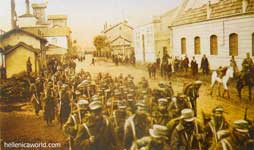
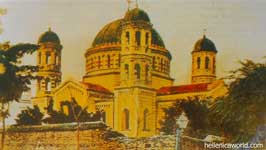
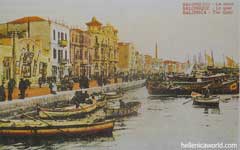
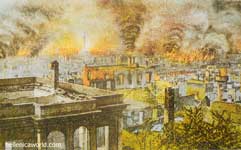
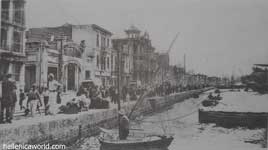
External links
Government
Municipality of Thessaloniki
Thessaloniki Port Authority
ΟΑΣΘ – Organisation of Urban Transport of Thessaloniki (Greek & English)
Thessaloniki – Photo Archive Documents 1900–1980
Tourism
You in Thessaloniki: Official promotional video for Thessaloniki by the Greek National Tourism Organization
Cultural
Thessaloniki Concert Hall Organisation
Thessaloniki Film Festival
Thessaloniki – Old postcards
Thessaloniki Info & Links
Thessaloniki360 Virtual City Guide
Thessaloniki Tsimiski.gr street
|
Municipalities of the Thessaloniki Prefecture Agios Athanasios | Agios Georgios | Agios Pavlos | Ampelokipoi | Apollonia | Arethousa | Assiros | Axios | Chalastra | Chalkidona | Chortiatis | Echedoros | Efkarpia | Egnatia | Eleftherio-Kordelio | Epanomi | Evosmos | Kalamaria | Kallindoia | Kallithea | Koroneia | Koufalia | Lachanas | Lagkadas | Madytos | Menemeni | Michaniona | Mikra | Mygdonia | Neapoli | Oraiokastro | Panorama | Pefka | Polichni | Pylaia | Rentina | Sochos | Stavroupoli | Sykies | Thermaikos | Thermi | Thessaloniki | Triandria | Vasilika | Vertiskos |
| Ancient Greece
Science, Technology , Medicine , Warfare, , Biographies , Life , Cities/Places/Maps , Arts , Literature , Philosophy ,Olympics, Mythology , History , Images Medieval Greece / Byzantine Empire Science, Technology, Arts, , Warfare , Literature, Biographies, Icons, History Modern Greece Cities, Islands, Regions, Fauna/Flora ,Biographies , History , Warfare, Science/Technology, Literature, Music , Arts , Film/Actors , Sport , Fashion --- |
Retrieved from "http://en.wikipedia.org/"
All text is available under the terms of the GNU Free Documentation License


